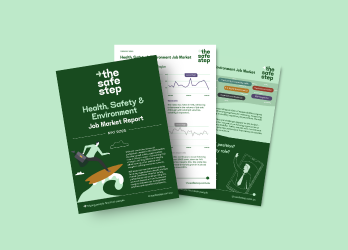The Rule of 3: Land that role
Page Published Date:
May 8, 2024
The professional HSE employment market soared post-Covid, with unprecedented demand for health and safety expertise. While that initial surge has leveled off, the need for skilled HSE professionals remains strong.
In today's more normalized job market, HSE candidates may need to sharpen their approach. Craig Mason highlights some simple yet effective strategies he's seen boost job search success, including leveraging 'The Rule of 3'.

The Rule of 3: Land that Role
The term, 'The Rule of 3' has many applications. Everything from goal setting to visual design in areas such as photography and landscaping. In literature and the spoken word, it can refer to a collection of three words, phrases, sentences, lines, paragraphs/stanzas, chapters/sections of writing and even whole books.
The use of the Rule of 3 is powerful as it creates a pattern. Patterns are recommended in structuring various forms of Communications such as in speeches where the basic pattern/plan is;
- Tell them what you are to going to talk about;
- Tell them; and finally
- Tell them what you told them.
So what is the most important aspect of Job Searching? I would argue it is, Communication! Job Searching is of course a combination of both verbal and written Communication. To get the best outcome, both have to be effectively delivered to ensure a recipient, who is usually under pressures of some description, receives the best version possible -- job searching is competitive after all.
How then can The Rule of 3 be applied to improve the Job Search Communication process?
The spoken word
Tell me a bit about your career/ background? This is an example of the most obvious first question in most interviews. How do most people deal with this style of question?
Many people, in my experience, immediately snatch defeat from the jaws of victory by not having a simple plan to break their career into bit size chunks. The narrative is often long, meandering and not related to the specific role they are there to talk about.
A plan using The Rule of 3 can be applied to structure a response;
- Foundation (Early Career) -- "my early career gave me foundational experience in X, Y and Z working across a range of HSE roles. (20% of time)
- Intermediate (Mid Career) -- "using this foundation, I was fortunate to be promoted and /or recognised to take on HSE leadership roles that also gave me exposure to various C Suites in a number of roles (in Aust/o'seas) as well as opportunities to lead projects in A,B and C. These roles were undertaken with the background of a major merger/ takeover/ cost reduction/ economic uncertainty etc" (30% of time)
- Consolidation (Later Career) -- "I have been able to bring together my previous X years' experience in my recent roles and have reported to senior Business leaders whilst leading HSE teams in large complex businesses nationally/internationally. I have on occasions been asked to manage significant Group wide projects and/or other functions such as Risk, Property etc etc. These roles have also provided the significant opportunity to work directly to Boards and their Sub Committees etc etc." (50% of time)
Using the Rule of 3 plan in interviews;
- It can be effectively employed no matter if someone has 5, 15 or 30 years experience.
- The reader has your cv -- they don't need you to rehash it blow by blow. This is an opportunity to start to highlight experiences against the specific role/ organisation requirements.
- If this opening response is planned well, it can be delivered in 5 to 10 mins tops. That in itself will be unique as many take this question as an open invitation to drone on for 20 mins. (talk about snatching defeat from the jaws of victory !)
- Additional questions in the interview can be responded to by using the Rule of 3. This has been commonplace for many years in the format of 'Situation, Action, Results'. Even if a question isn't asked in this style, an efficiently delivered response in this format is literally GOLD!
The written word
LinkedIn is a great vehicle to position individuals for the roles you want moving forward before even meeting a prospective client and the Rule of 3 can be very effectively used.
This can be done by highlighting how functional areas that individuals have led or worked within, have contributed to the organisations performance and therefore why someone would feel like they need to talk with you if they don't know you.
The Rule of 3 plan for a solid LinkedIn profile (and/or CV) should be
- The organisation context - What does the organisation do, its scale/headcount, strategy, structure and its turnover. This can be done with a personalised approach e.g. "Leading (or part of ) a passionate HSE team that support 2500 colleagues in 58 locations deliver health and safety outcomes that protect lives across Australia. Our strategy is driven by an opportunity to be the best/largest/most ethical provider of HSE services in Australia".
- How the function has added value --By demonstrating an understanding of the context, describe how the function has added value and what was that value? e.g. "Delivered a range of commercially focused HSE programs/systems/ projects across a range of job families and client groups effectively and under budget with an internal average rating of 90".
- The results -- Outline the contribution to the overall business results using whatever non-commercial-in-confidential data is available. e.g. "By ensuring that the organisation had the right HSE capability, our team contributed to long-term contract extensions in 2 states and securing a new contract in X. These commercial successes will have a material impact on the future revenue of the company".
Using the Rule of 3 plan in LinkedIn profiles and CV's;
- Like verbal communications, this can be employed by early career professionals through to C Suite executives;
- The hardest profile or cv to write will always be your own -- it's the same for everyone, particularly people who are not natural self-promoters.
- The value added and actual outcomes are often a missed opportunity in many people profiles.
- LI profiles particularly should be viewed through the lens that this is a marketing document for the roles you want in the future i.e. Executive HSE Leadership roles and "being proud of the organisation that I have been a leader of etc.........." and by definition will then be a passionate and quality member of the HSE team that I work for and with, in the future! (and please, in LI profiles have an appropriately professional headshot!)
The final word
By using a simple plan such as The Rule of 3 in interviews and LI profiles, Job Seekers can stand out and distinguish themselves from their peers in market by communicating more effectively and professionally.
By standing out and taking every advantage possible, the next right career opportunity is bought closer and whilst some time is required up front to prepare, this could save many hours down the track.
How we can help
If you're a HSE professional looking to better communicate your value and land your next role, or an employer needing to build a top-tier HSE team, contact us.
Our consultants can guide you through leveraging the "Rule of 3" approach to craft impactful written profiles and verbal interviews that truly set you apart.




